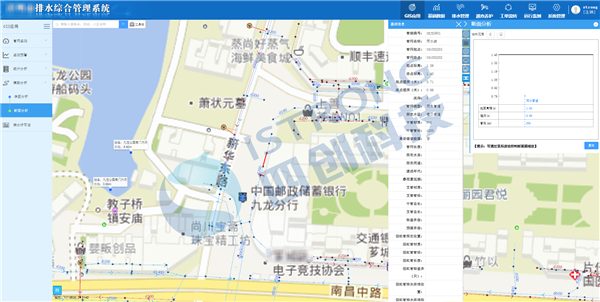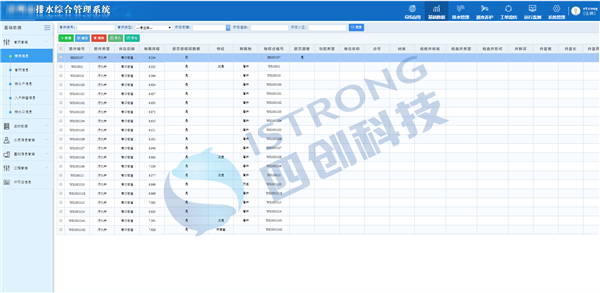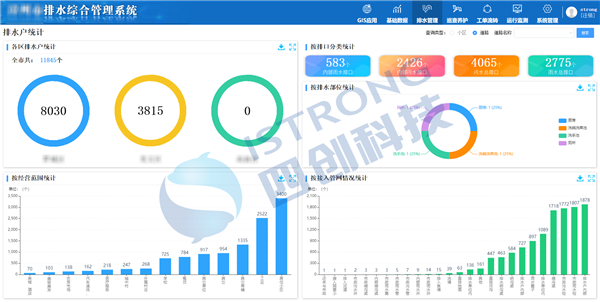
Urban Drainage and Flood Control Comprehensive Management Platform
Through years of project practice and market system demand analysis, ISTRONG has proposed a solution for the Urban Drainage and Flood Control Comprehensive Management Platform, based on the basic design concept of the Digital Municipal Engineering Plan and drawing on the development experience of similar systems at home and abroad, using advanced and scientific information technology.In recent years, "black swan" events that threaten urban operational safety have occurred frequently, such as extreme weather, natural disasters, human destruction, new pollutants, and sudden pollution incidents. Meanwhile, the planning and construction standards of urban drainage infrastructure are not high enough to meet the needs of urban economic and social development. The increasingly severe water safety, water environment, and water ecology issues require urban managers to integrate and analyze information resources with strong data capabilities, to grasp real-time information on the operation of municipal drainage infrastructure, identify risks, respond in a timely manner, reduce the impact of disasters, and safeguard public safety.
Through years of project practice and market system demand analysis, ISTRONG has proposed a solution for the Urban Drainage and Flood Control Comprehensive Management Platform, based on the basic design concept of the Digital Municipal Engineering Plan and drawing on the development experience of similar systems at home and abroad, using advanced and scientific information technology.

Construction Content
➤By establishing a comprehensive system framework and information standardization, we aim to minimize future redundant construction and lay a solid foundation for system development, construction, and subsequent operation and maintenance.
➤By constructing a drainage and flood prevention data center, we can integrate diverse and heterogeneous data sources and extract valuable insights for data-driven applications.
➤Utilizing an SOA architecture for application system development, we provide lightweight business application system functions supported by data to assist drainage management operations.
➤By incorporating BIM, AR, and 3D GIS technology concepts, we create an integrated 2D and 3D homepage, offering a global, single-map visualization for monitoring purposes.
➤We support the integration of municipal pipeline network models, water quality models, and online dispatch models, providing auxiliary decision-making services for integrated drainage and flood prevention management within the context of digital municipal governance.
➤The system offers a wealth of mobile applications and information portal resources to meet the needs of operation and maintenance support, higher-level supervision, public oversight, and the development of water culture.

▲GIS Application

▲GIS application for analysis assistance

▲Basic data for manhole information

▲Drainage management

▲Inspection and maintenance
Program highlights
1、Standardize data standards and promote resource integration
The construction of standard specifications mainly includes two aspects. On the one hand, it is necessary to comb through national and industry standards and specifications for information collection, data resources, operation environment, software development, and information security. On the other hand, if there are no national or industry standards to follow, it is necessary to supplement the necessary standard specifications.
The standardization system plays an extremely important role in the informationization construction of drainage and flood control. Only by using standardized means such as unified technical requirements, business requirements, and management requirements, can related engineering and related links of informationization construction be regulated, forming an organic whole, avoiding blindness and repetition, reducing construction and maintenance costs, and improving comprehensive project benefits.
2、Plan data resources and precipitate data value
With the goal of "one data, one source", the means of "integration, transplantation, and supplementation", and the aim of "sharing and service", existing drainage and flood control data resources in the city are utilized to build a seamless connection and highly integrated data center. By integrating, transplanting, and supplementing basic databases, professional databases, spatial databases, shared databases, thematic databases, and meta-databases, data can be shared in an orderly manner, with high efficiency, reliability, and security. The advanced, practical, secure and reliable information resource storage management, shared exchange, application services and other functions are integrated into a whole, forming a detailed municipal integrated data resource center.
3、Integration of Business Platform and Optimization of Application Integration
Through project construction, the existing drainage and flood control business systems are integrated into the integrated fusion platform for resource integration. This platform provides a centralized display of application data such as water conditions, rainfall conditions, construction progress, water quality, videos, user facilities, operation and maintenance events, and regulatory assessments. It also provides graded management of drainage scheduling, agricultural pollution control, patrol and maintenance, and other business topics to provide more comprehensive perception network, multi-dimensional data perspectives, more streamlined business processes, and more thoughtful platform support services.
4、Data sinking for mobile devices, information at your fingertips
Mobile system construction provides various forms of application such as APP, WeChat, and mini-programs to meet the needs of production and operation monitoring, online collaboration assistance, and data sharing and publishing. Customized data service strategies and application functions are provided for production management, regulatory decision-making, and public service layers, which conform to usage habits and unleash the value of data.
5、Incubating intelligent applications to deepen data value
Through the design of model algorithms and development of API ports, intelligent application functions are realized in various application scenarios of drainage and flood control. Examples of these intelligent application functions include customized data report template generation for management, automatic recognition of illegal behavior and abnormal working conditions in video monitoring images, simulation and traceability analysis of the process of rain and sewage mixing, and intelligent analysis functions for pipe bursts in the drainage network. The goal is to maximize the value of existing data assets and ensure the overall advancement and scientific nature of the system construction.
6、Establishing an operation and maintenance system to ensure long-term stability
Through the promotion of information platform and local drainage and flood control integration, a professional operation and maintenance system is established to provide a comprehensive operation and maintenance service guarantee system from team construction, content design, operation and maintenance plan, maintenance mechanism, to management system. This ensures the long-term stable and secure operation of information technology equipment and continues to serve the satisfaction improvement of the public towards municipal service facilities.
